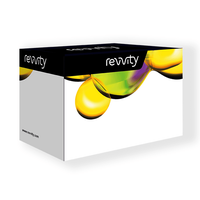

HTRF Human Phospho-SLP-76 (Tyr145) Detection Kit, 500 Assay Points






The phospho-SLP-76 (Tyr145) kit enables the cell-based quantitative detection of phosphorylated SLP-76 at Tyr145, for monitoring T-lymphocyte activation.
For research use only. Not for use in diagnostic procedures. All products to be used in accordance with applicable laws and regulations including without limitation, consumption & disposal requirements under European REACH regulations (EC 1907/2006).
Product information
Overview
This HTRF cell-based assay enables rapid, quantitative detection of SLP-76 phosphorylated on Tyrosine 145. Phosphorylation of SLP-76 by ZAP-70 kinase creates a scaffold on which key signaling complexes are built in order to trigger T-lymphocyte activation. SLP-76 (Tyr145) is considered as a direct readout of the ZAP-70 activation pathway in T-immune cells.
Specifications
| Application |
Protein Detection
|
|---|---|
| Assay Points |
500
|
| Assay Target Type |
Kit
|
| Assay Technology |
HTRF
|
| Automation Compatible |
Yes
|
| Brand |
HTRF
|
| Detection Method |
HTRF
|
| Experimental Type |
In vitro
|
| Quantity |
1
|
| Shipping Conditions |
Shipped in Dry Ice
|
| Therapeutic Area |
Oncology & Inflammation
|
| Unit Size |
500 Assay Points
|
Video gallery


How it works
Phospho-SLP-76 (Tyr145) assay principle
The Phospho-SLP-76 (Tyr145) assay measures SLP-76 when phosphorylated at Ser376. Unlike Western Blot, the assay is entirely plate-based and does not require gels, electrophoresis, or transfer. The Phospho-SLP-76 (Tyr145) assay uses 2 labeled antibodies: one with a donor fluorophore, the other with an acceptor. The first antibody was selected for its specific binding to the phosphorylated motif on the protein, the second for its ability to recognize the protein independent of its phosphorylation state. Protein phosphorylation enables an immune-complex formation involving both labeled antibodies and which brings the donor fluorophore into close proximity to the acceptor, thereby generating a FRET signal. Its intensity is directly proportional to the concentration of phosphorylated protein present in the sample, and provides a means of assessing the protein’s phosphorylation state under a no-wash assay format.

Phospho-SLP-76 (Tyr145) 2-plate assay protocol
The 2 plate protocol involves culturing cells in a 96-well plate before lysis, then transferring lysates into a 384-well low volume detection plate before the addition of Phospho-SLP-76 (Tyr145) HTRF detection reagents. This protocol enables the cells' viability and confluence to be monitored.

Phospho-SLP-76 (Tyr145) 1-plate assay protocol
Detection of Phosphorylated SLP-76 (Tyr145) with HTRF reagents can be performed in a single plate used for culturing, stimulation, and lysis. No washing steps are required. This HTS designed protocol enables miniaturization while maintaining robust HTRF quality.

Assay validation
HTRF assay compared to Western Blot using phospho SLP-76 (Tyr145) cellular assay on human Jurkat cells
Jurkat cells were grown in a T175cm2 flask for 2 days in RPMI culture medium supplemented by 10% FBS, at 37°C in 5% CO2 atmosphere. 1.8 mL of cell suspension (1x107 cells / ml) were stimulated with Pervanadate (10 mM final concentration, for 15min). After stimulation, the cells were lysed at RT for 30 min by adding 0.6 mL of 4X supplemented lysis buffer. Neat lysate was then serially diluted in the same supplemented lysis buffer. 16 µL of each dilution were analyzed in parallel by HTRF or by Western Blot. Specific TCR activation by the anti-CD3 Ab treatment was assessed with HTRF (pharmacological validation, section below), but no detection was possible with the Western Blot technique, due to a lack of sensitivity.

Kinetics of cell stimulation with the specific anti-CD3 antibody activator
This assay was carried out with a two plate protocol. 400,000 Jurkat cells per well were plated in a 96-well culture plate at 25µL/well, in complete RPMI culture medium with 10% FBS. Cell stimulation was performed using anti CD3 Ab at the final concentration of 20µg/mL for different stimulation times (min). After stimulation, cells were lysed with 10 µL of 4X supplemented lysis buffer. 16 µL of each cell lysate for the different conditions were analyzed by HTRF Phospho SLP-76(Tyr145) and Total SLP-76. The anti-CD3 antibody induced a significant phosphorylation of SLP-76 which reached its maximum after 5min stimulation, whereas Total SLP-76 remained stable under the same conditions.

Modulation of SLP-76 kinase activity in human Jurkat cells
The T-Lymphocyte immortalized Jurkat cell line was seeded in a 96-well culture-treated plate under 400,000 cells/well in complete culture medium, and incubated overnight at 37 °C, 5% CO2. For SLP-76 activation experiments, the cells were treated with the anti-CD3 antibody at various concentrations for 5 min. After treatment, the cells were lyzed with 50 µL of supplemented lysis buffer #4 for 30 minutes at RT under gentle shaking. For the detection step, 16 µL of cell lysate were transferred into a 384-well low volume white microplate, and 4 µL of the HTRF Phospho-SLP-76 (Tyr145) or Total-SLP-76 detection reagents were added. The HTRF signal was recorded after 3H for the Phospho-SLP-76 (Tyr145) assay and overnight for the Total-SLP-76 assay. The anti-CD3 antibody induced a significant activation of the ZAP-70 pathway, leading to a 3-fold increase in SLP-76 phosphorylation in Jurkat cells, whereas Total SLP-76 remained stable under the same conditions.

Simplified pathway
Function and regulation of SLP-76
TCR engagement promotes the phosphorylation of immunoreceptor tyrosine-based activation motifs (ITAMs) on the cytosolic side of the TCR/CD3 complex by lymphocyte protein tyrosine kinase (Lck). Zap-70 is recruited to the TCR/CD3 complex, where it becomes phosphorylated and activated. ZAP-70 phosphorylates SLP-76. Activated SLP-76 translocates to the plasma membrane and promotes a multi-protein complex, which participates in the activation, survival, and proliferation of T-Lymphocytes

Resources
Emerging pathways to neuroinflammation and neurodegeneration
Neurodegenerative diseases, such as amyotrophic lateral sclerosis...
This guide provides you an overview of HTRF applications in several therapeutic areas.

SDS, COAs, Manuals and more
Are you looking for technical documents for this product. We have housed them in a dedicated section., click on the links below to explore.


How can we help you?
We are here to answer your questions.































